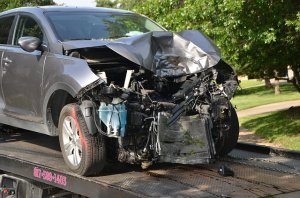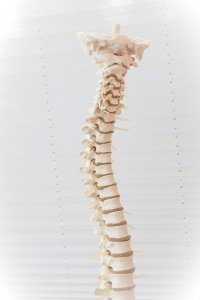Back Injuries
Back Injuries From Car Accidents

Everyday, people all over the country injure their back in a car accident. It’s possible to injure your back whether the accident is a head-on, side-impact, or rear-end collision. Back injuries are one of the most common when it comes to vehicle accidents; the back is simply not made to withstand the trauma that can occur in case of a collision.
Back injuries include anything from a mild sprain or bruise to something as serious as a fractured vertebrae or spinal cord damage. These devastating injuries can affect you for the rest of your life and can cost you thousands of dollars in medical bills.
Accidents result from many things including, but not limited to:
- Distracted driving
- Reckless behavior
- Fatigued
- Driving while intoxicated
- Severe weather
About the Back
Back injuries are the most common type of injury resulting from car accidents. The back is a complex system of muscles, bones, tendons, ligaments, and nerves. There are so many ways that complex system can be disrupted in the case of an auto accident. Even if you were wearing a seatbelt at the time of the accident, the impact may injure your back.
After an accident, take note of how you feel not just the day of, but the day after as well. Sometimes the shock of an accident makes it hard to notice trauma until the next day. Your pain may not be located solely in the back area. Common symptoms of back injury include pain up and down the legs, numbness in your extremities, and weakening of muscles.
The most serious back injuries involve the vertebra. Your vertebra runs up and down your back and consists of 24 separate vertebrae. Between each vertebrae lies a disc that cushions the bones of the spine and helps protect the spinal cord. Muscles, ligaments, nerves, and tendons surround the spine and vertebra. If a nerve ending contacts damaged tissue, disks, vertebrae, or a bruised spinal cord, the resulting pain can be excruciating.
Doctors divide your vertebra into three sections:
- The cervical vertebra – Six disks behind the neck
- The thoracic vertebra – Twelve disks that run down the center of your back
- The lumbar vertebra – Five disks that make up the lower back region
Types of Back Injuries

Now that you know how the back is built, you’ll have a better understanding of the various types of back injuries that result from car accidents.
- Soft tissue bruising – The muscles, tendons, and ligaments surrounding the vertebra stretch or tear, affecting thousands of nerve endings and resulting in pain
- Herniated disc – A disc breaks open and part of its inner cartilage begins to stick outward
- Bulged disc – Damage to the spine pushes a disk out of its natural position
- Compression fracture – The front part of the vertebra and spine compresses downward and fractures
- Dislocation fracture – Nearby soft tissue moves into a fractured vertebrae
- Transverse process fractures – The vertebra and spine twist past their natural radius, resulting in fracture
- Flexion distraction fracture – The upper vertebra and spinal cord bend violently forward upon impact and fracture vertebrae.
- Axial bursts – Multiple vertebrae in both the cervical and lumbar regions disintegrate due to impact.
Spinal Cord Injuries

Spinal cord injuries can be a result of other Pain injuries along the back, including broken or dislocated vertebrae. In the case of spinal cord injury, bleeding or swelling may occur around the spinal cord. Symptoms are serious:
- Tingling
- Numbness
- Spasms
- Loss of sensation
- Immobility
- Difficulty breathing
- Libido changes
- Loss of bladder or bowel control
Proof of Liability
If you are in a car or motorcycle injury resulting in back injury, there will be questions establishing who is liable for the accident. Liability is determined by who was at fault and consequently caused the accident. Various factors help determine liability:
- Statements from witnesses – When police arrive at the scene, they will collect statements from witnesses. These people may have seen the other driver make an illegal move or saw him on his cell phone while driving. Whatever the witnesses say can be used to prove liability.
- The police report – In addition to witness testimony, what the police write down when they arrive at the scene is also evidence of liability. A police report may include a diagram of the scene, names of the witnesses, their own opinions about fault, and what tickets they issued at the time of the accident.
- Photographs of the scene – Back in the day, insurance companies suggested drivers keep a disposable camera in their glove box to take photos in case of an accident. Nowadays it’s even easier with the cameras on our smart phones. Take clear, detailed photos of the wreck and the damage around you if you are able to in the case of an accident.
- Medical records – If the car accident results in back injury, it is crucial that you keep and document your medical records. These will tie your back injury to the collision. The attending doctor’s report should be clear and concise. If you look at the report and things are vague, you have every right to request the doctor edit it for accuracy.
No-fault vs. At-fault
If you live in a no-fault insurance state, your own insurance claim will cover your medical treatments, out-of-pocket expenses, and lost wages. States implement no-fault insurance systems to reduce the number of negligent driver lawsuits
If you live in an at-fault insurance state, the at-fault driver’s insurance company should reimburse you for your damages. You have to get the other driver’s insurance information and file a claim separately. If this is the case for you, gather evidence and act as quickly as you can to make sure you are compensated. If you feel you are not fairly compensated for the amount of damage done, you can file a lawsuit against the driver at fault.
Back Injury Attorney
Even if your back injuries are not too severe right now and only involve minor sprains or tears, you should still see your doctor and make sure everything is okay. However, if the injuries are severe like the ones above, contact a car accident attorney as soon as you can.
Laws regarding how long you have after an accident to file a lawsuit vary state by state. These laws are called “statute of limitations” and range from one to five years. Consult an attorney about your state’s statute of limitations so you are justly compensated for your back injury. Call Silver Injury Law for a Car Accident Lawyer in Boca Raton.



